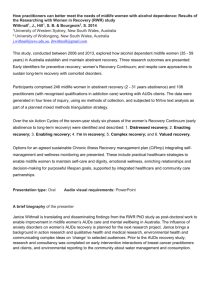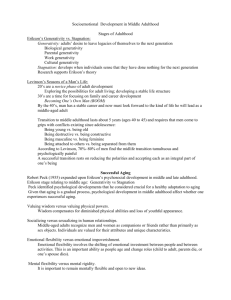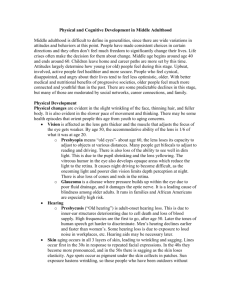Middle adulthood - FacultyWeb Support Center
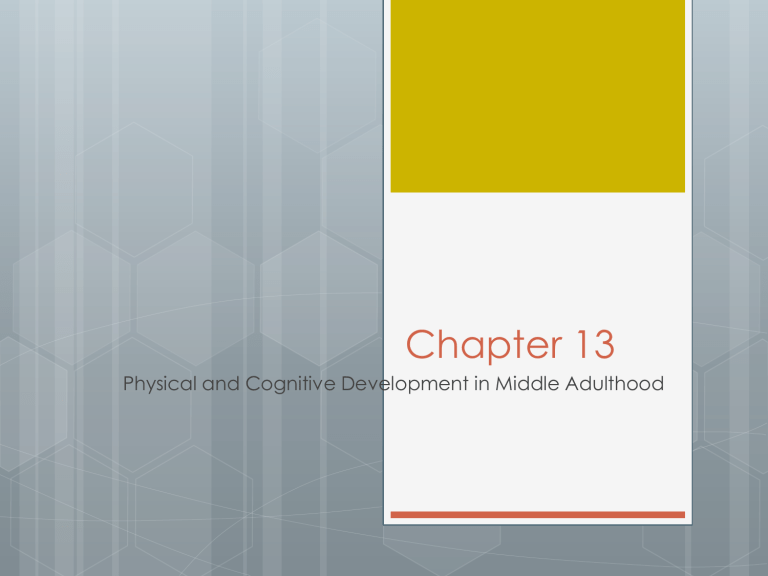
Chapter 13
Physical and Cognitive Development in Middle Adulthood
Changing Midlife
Today, many 50-year-olds are in better shape, more alert, and more productive than 40year-olds a generation or two ago
Middle age is starting later and lasting longer
Jung -- “Midlife is the afternoon of life”
Increasing percentage of population is made up of middle-aged and older adults
Best-educated and most affluent cohort
Defining Middle Adulthood
Middle adulthood -- developmental period beginning about 40 and extending to 60–65 years
period of declining physical skills and increasing responsibility shrinking time left in life reach and maintain satisfaction in career individuals make choices
Gains and Losses
Late midlife may be characterized by the loss of a parent, the last child leaving the home, becoming a grandparent, preparation for retirement, and actual retirement
Overall, gains and losses may balance each other in midlife
losses may begin to dominate gains for many individuals in late midlife
Midlife is characterized by individual variations
Physical Changes
Some of the visible signs
Skin begins to wrinkle and sag
Areas of pigmentation in skin produce age spots
Thinning and graying hair
Interest in plastic surgery, Botox, weight control, and vitamins may reflect the desire to take control of the aging process
Height and Weight
Individuals lose height in middle age
Many gain weight
body fat makes up 20 percent or more of weight in midlife as compared to 10 percent in adolescence almost 1/3 of adults 40–59 years are classified as obese
obesity increases probability of other health issues
(Centers for Disease Control and Prevention, 2006)
Vision and Hearing
Accommodation of the eye -- ability to focus and maintain image on the retina declines between 40 and 59 years
more need for glasses and/or bifocals
Hearing also declines after age 40
sensitivity to pitches decreases men lose sensitivity earlier than women
resulting from exposure to occupational noise
Cardiovascular System
High blood pressure and cholesterol issues become problematic
Women’s blood pressure rises at menopause and typically remains higher than men’s
Exercise, weight control, proper dietary patterns can help decrease problems
Metabolic syndrome is an increasing problem
Characterized by hypertension, obesity, and insulin resistance
Lungs
Little change in lung capacity through most of middle adulthood
In late 50s, proteins in lung tissue become less elastic, decreasing lung capacity
Smokers experience most significant changes
lung capacity improves with quitting smoking
Sleep
Beginning in 40s, more wakeful periods are more frequent, and there is less of the deepest sleep
More time lying awake results in feeling less rested
Sleep problems are more common for those who use a higher number of prescription and nonprescription medications, are obese, are depressed, or have cardiovascular disease
Health habits through the years
What are health habits that can contribute to lower vitality? How is it lowering vitality?
Think of a bad health habit that you or someone you know exhibits and think of ways to change or manage the habit to become healthier.
Health and Disease
Frequency of accidents declines
Individuals are less susceptible to colds and allergies
Stress is found to be a factor in disease
Chronic Disorders
Chronic disorders are rare in early adulthood
Chronic disorders -- slow onset and long duration
Stress is found to be a factor in disease
Culture affects cardiovascular disease
(Hertz, Unger, & Ferrano, 2006)
Mortality Rates
In middle age, many deaths are caused by a single, readily identifiable cause
Leading causes
heart disease cancer
cardiovascular disease
Men have higher mortality rates than women for all of the leading causes of death
(National Center for Health Statistics, 2008)
Sexuality
Climacteric -- midlife transition in which fertility declines
Osteoporosis
Menopause
women’s menstrual periods completely cease side effects of menopause vary
cross-cultural studies reveal wide variations
Treating Effects of Menopause
Hormone replacement therapy (HRT) -augments declining levels of reproductive hormone production by the ovaries
usually estrogen and progestin
negative side effects for HRT
increased risk of stroke and cardiovascular disease
Decreased use of HRT has shown a related decline in the incidence of breast cancer
Hormonal Changes in Middle-
Aged Men
father children
Modest decline in sexual hormone level and activity
“Male menopause” probably has less
decline
Testosterone levels decline and can reduce sexual drive
Most erectile dysfunctions stem from physiological problems
treatment has focused on drug therapy
Fluid and Crystallized
Intelligence
Crystallized intelligence -- individual’s accumulated information and verbal skills
Fluid intelligence -- ability to reason abstractly; begins to decline in middle adulthood
When studying intelligence, whether data is collected cross-sectionally or longitudinally makes a difference in results
Speed of Information
Processing
Perceptual speed begins declining in early adulthood and continues declining in middle age
Memory
Controversy about whether memory declines in the middle years -- most experts agree there is some decline, at least in late middle age
More time is needed to learn new information
The slowdown has been linked to working memory -the mental “workbench” where individuals manipulate and assemble information when making decisions, solving problems, and comprehending written and spoken language
Memory decline is more likely to occur when individuals do not use effective memory strategies
Expertise
Expertise shows up more in middle adulthood
Expertise involves having extensive, highly organized knowledge and understanding of a particular domain
result of many years of experience, learning, and effort
Work in Midlife
Central during the middle years
Reach peak of position and earnings
Middle-aged adults may experience age discrimination
May have multiple financial burdens
Time of evaluation, assessment, rebalance, and reflection
Career Challenges and
Changes
Globalization of work
Developments in information technologies
Downsizing of organizations
Early retirement
Concerns about pensions and health care
Some career changes are self-motivated; others are the result of job loss
Leisure
Leisure -- pleasant times after work when individuals are free to pursue activities and interests of their own choosing
midlife changes may produce more time for leisure
Adults in midlife need to begin preparing for retirement
leisure can be a part of this preparation
Religion and Adult Lives
Majority of middle-aged adults profess religious beliefs and consider spirituality a major part of their lives
For some, religion is a major influence to some adults but may play little or no role in others’ lives
Females show stronger interest and participate more
Religion and Health
Researchers have found that religious attendance is linked to
a reduction of blood pressure and hypertension
increased longevity
Religion promotes health
lifestyle issues social networks coping with stress
Meaning in Life
Frankl said that the three most distinct human qualities are:
Spirituality
Freedom
Responsibility
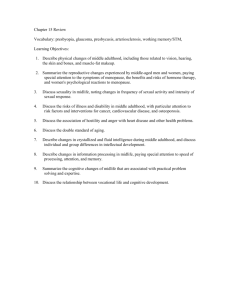
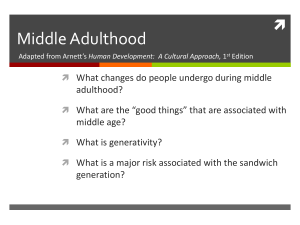

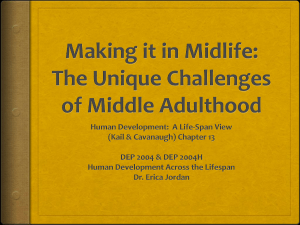
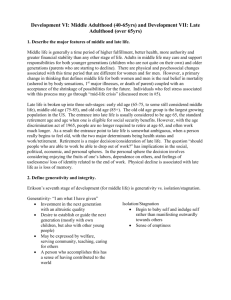
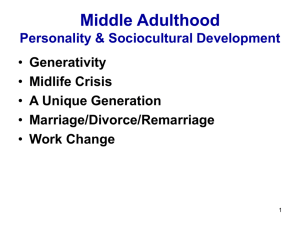
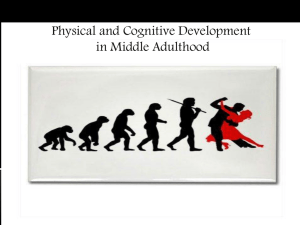
![Adulthood andaging[1]](http://s3.studylib.net/store/data/009423432_1-4447cad1799ab03eaf7339901cd9d417-300x300.png)

